
Cloud seeding is being used more extensively to protect French vineyards from damaging hail storms this year. It has been used for years to also increase rain or snow or even dissipate clouds.
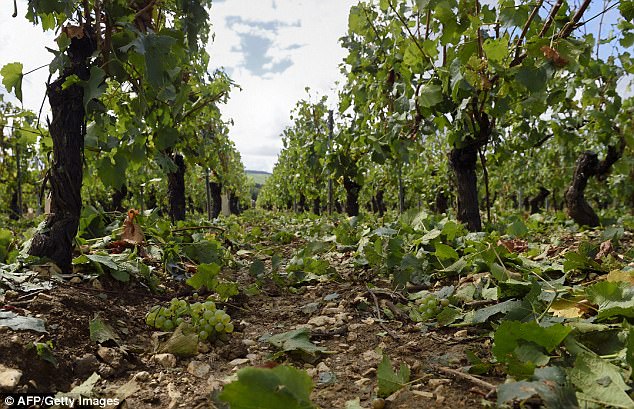
Vineyards in Burgundy in eastern France will be the first in the country, which is the world’s second largest producer of wine (behind Italy), to be extensively protected by a ‘shield’ to help mitigate against damaging hail storms that have blighted the area and caused losses of up to 100% in recent years. More in this story was published in the Daily Telegraph last Saturday.
Also in the Daily Mail
The vineyard ‘hail shield’ is based on a cloud-seeding system which is also used across the wine regions of Bordeaux and southwest France. However, this will be the first time in France that it will be used in every vineyard, following recent years where entire vineyards have been destroyed by hail up to golf ball size, causing huge loses to growers. Wine growers have even trialed anti-hail nets, but this is a more expensive way of protecting grape vines:
The hail shield consists of generators placed in or near the vineyards which release tiny silver iodide particles up about 1km into the atmosphere. In theory, the silver iodide particles that rise up as a cloud into the sky catalyse super-cooled water droplets in the clouds to freeze at a warmer temperature and more abundantly than they might have otherwise. This means rather than forecasted severe thunderstorms clouds producing large hail up to golf-ball size, the clouds produce rain and small hail instead.
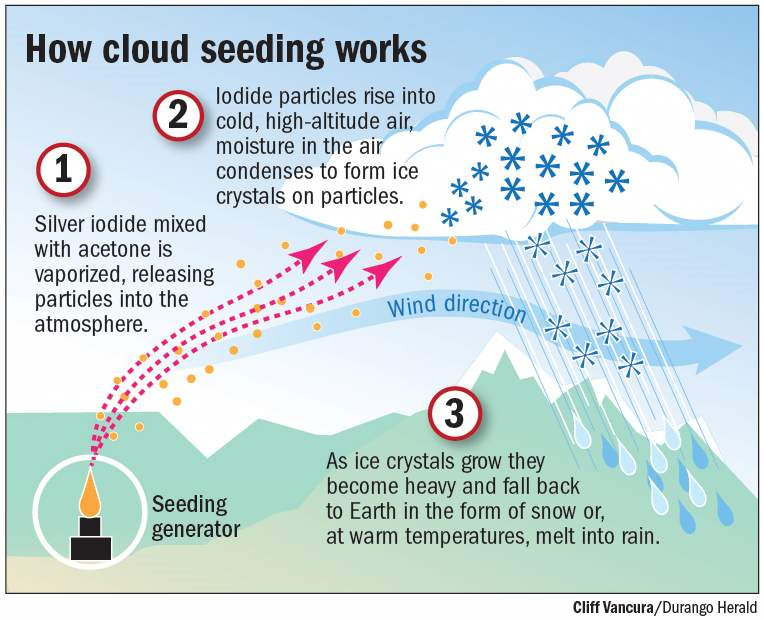
Although large hail in the UK is pretty rare, it is fairly common during the warmer months in France and other countries in mainland Europe. Large hail typically forms in multicell or ‘supercell’ thunderstorms during late spring, throughout summer and well into autumn. The conditions for large hail formation requires the following:
Large updraft speeds can be expected in storms that develop in environments of large CAPE (Convective Available Potential Energy) or in supercell storms. Supercell storms can occur with both low and high CAPE, but almost exclusively with strong vertical wind shear. Vertical wind shear is where winds increase and veer with height. High liquid water content above the freezing level is usually associated with moist air (with high dew points) that originally entered the storm lower down.
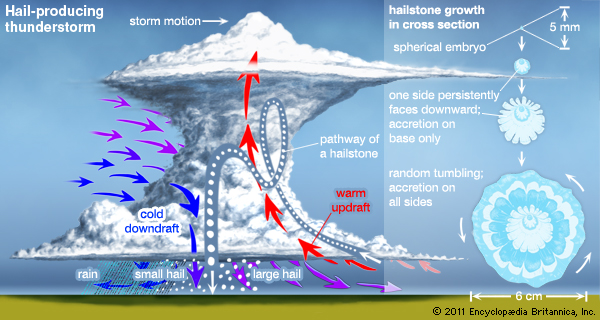
Storm duration is strongly influenced by wind shear. Updrafts of single cell storms may often not live long enough for hailstones to grow very large. Multicell and supercell storms are associated with moderate to strong vertical wind shear, which means that the downdraft is tilted away from the updraft areas allowing the storm to live longer and may therefore be more often associated with large hail. So, we may expect that environments supportive of large hail are characterized by
These multicell or supercell thunderstorms can often occur in the warmer months over much of France, when a combination of cooler air aloft off the far North Atlantic overrides warm and humid air at the surface spreading up from the Mediterranean or sub-tropical North Atlantic creating strong instability when the surface is heated to high temperatures inland, creating thunderstorms. Furthermore, large amounts of CAPE can be generated when warm and dry layers (an Elevated Mixed Layer or EML) in the mid-levels of the troposphere (where our weather happens) originating from the Spanish Plateau rides above warm moist air at the surface to create a lid that builds up large amounts of fuel for storms when the surface is heated to high temperatures. This is because parcels of heated moist air cannot rise through the warm dry layers aloft (parcel has to be warmer than surrounding air to continue to rise) until the convective temperature is reached or a forcing mechanism such as trough or front arrives to break the lid or cap. These ‘loaded gun’ scenarios are often responsible for the strongest storms and largest hail.
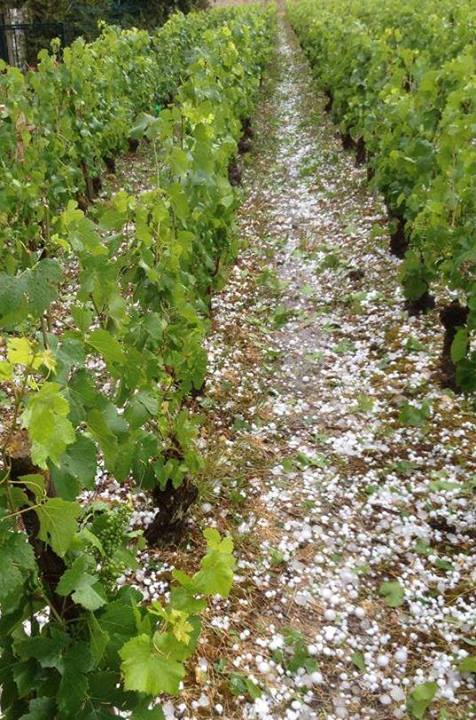
Cloud seeding first began in the mid 1940s when Dr. Vincent J. Schaefer was studying cloud formation for General Electric. Cloud seeding has been subsequently used to enhance precipitation, dissipate fog, modify hurricanes, and decrease lightning and hail in thunderstorms. Cloud seeding can occur naturally but is more often done by humans.
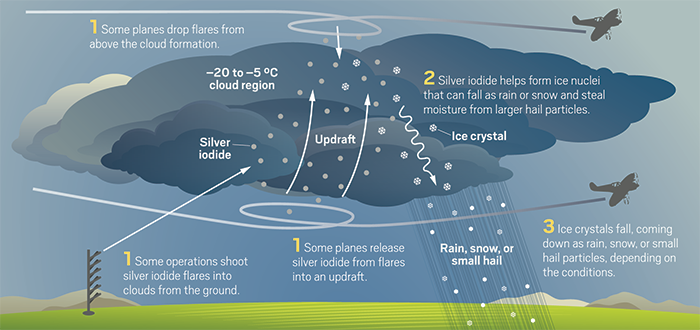
How cloud seeding is supposed to work. Weather modification firms launch silver iodide flares from planes or from the ground into cloud formations to try to increase rainfall or mitigate hailstorms. Credit: Yang H. Ku/C&EN/Shutterstock
Not only has cloud seeding been used to reduce the potency of hailstorms for years, it has also been used to try to enhance rain and snowfall for water storage in reservoirs and in the ground. Currently, more than 50 countries worldwide participate in cloud-seeding operations. Silver iodide has been used in cloud seeding because it has a similar physical structure to natural ice crystals. It is often used in combination with dry ice, which is very cold. The silver iodide lowers the temperature in the cloud and provides more ice crystal seeds, but doesn't freeze all of the liquid water, either. Ice crystals grow from the liquid freezing onto them and then the ice lumps together. The ice crystals then fall and create snow, and if they melt before reaching the ground, produce rain.
These cloud-seeding operations to increase rain and snowfall are growing in popularity. Almost half of the world’s population will be living in water-stressed areas by 2030, according to estimates from the United Nations.
Cloud-seeding isn’t just used to enhance rain and snowfall or supress hail formation, it can also be used to evaporate fog and clouds. This is particularly useful for aviation, at airports, when the fog is very cold, adding large quantities of dry ice causes the fog to dissipate because it turns all the liquid to ice, and the ice settles to the ground, leaving clear air. However, this only works with fog that is very cold, but not frozen.
At the 2008 Summer Olympic Games, Beijing authorities even employed cloud seeding to clear the air of pollutants and to keep it from raining over the Bird’s Nest stadium while the games were going on.
There has also been attempts to modify hurricanes using cloud seeding, though this has only been attempted a couple of times back in the 1960s. In these attempts, the hurricanes seeded weakened, one of them considerably, though it is not known for sure whether these hurricanes that were seeded weakened naturally or if the seeding contributed to their weakening. There has also been a recent study that looked at the concept of seeding clouds to make them last longer by increasing droplet concentration, this in turn cools the sea below the clouds – meaning there is less energy to feed the hurricanes. Also another study looked at how seeding a hurricane with saltwater could also tame it.
With many of these methods of cloud seeding to alter precipitation and cloud formation, there is a lot of controversy, because cloud seeding interferes with the atmosphere’s natural cycles. If cloud seeding is done on a large scale, it may lead to increased evaporation from outside the area seeded, because the seeded area in theory is taking away moisture. Though other studies suggest that cloud seeding is unlikely to steal moisture from sites downwind.
Also, there is the issue of the toxicity of the silver iodide. Although silver is toxic to aquatic organisms in large doses, the levels found in surface water after seeding are well below the toxic threshold of 50,000 ppt. However, cloud-seeding using silver iodide on a largescale may increase silver toxicity and other environmental issues – which may become a concern.